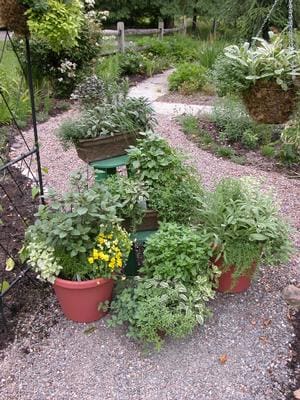Candy’s favority herbs for any garden.
There are hundreds of herb varieties, but there is not that much space in your garden center, so we’ll focus on the top 10 must-haves. Herbs such as catnip, chamomile, dill, hyssop and rue, to name a few, should all be part of an herb collection, but you don’t need to have as many of them.
Basil
The number one seller is ‘Sweet Genovese’, a culinary seed annual often used for pesto. Other superb varieties are ‘Siam Queen’, ‘Magic Michael’, ‘African Blue’ and ‘Dwarf Purple’. Basil needs a warm temperature no cooler than 60 degrees F. The soil should be slightly moist, not wet.
Rosemary
Rosemary officinalis is a tender shrubby perennial primarily used in cooking, but it has medicinal properties as well. There are many hardy varieties, such as ‘Hardy Hill’ and ‘Arp’. Rosemary prostrata ‘Haifa’ and ‘Irene’ have trailing growth. Plants have blue flowers during the winter months. Rosemary loves the sun and prefers to be slightly dry between thorough waterings. Do not let it wilt.
Lavender
This is my favorite herb because of the incredible fragrance and versatility. If the leaves are rubbed to release the oils, it has a calming effect. ‘Hidcote’ and ‘Munstead’ are most often requested, but they’re not necessarily the best. Lavender wants a dry location with lots of sunshine, good drainage and air circulation.
Thyme
Thyme is for happiness and strength and was once a symbol of courage. Plants bloom in many colors and form lovely mats of flowers that are pleasant to walk on or lay on. Thyme should be kept trimmed to promote new growth and requires good air circulation. The most popular varieties are English, golden lemon, silver and mother or creeping.
Sage
This handsome fellow emits a masculine smell and has a striking appearance. Sage has leathery foliage in gray, gold, purple or variegated. It is a vigorous grower and does well with rosemary and thyme. If a sage dies suddenly, tell your customer to not replant another one in the same place. Sage is susceptible to Rhizoctonia, a soil-borne disease that gives the appearance of a wilted plant. The new plant in the same spot will suffer the same fate.
Oregano
In spite of the confusion, these plants are easy to grow and edible. I was surprised to learn that it is one of the ingredients in vermouth. If overfed or over-watered oreganos can get out of hand. My favorite culinary varieties are Greek, ‘Hot & Spicy’ and Marjoram compacta. the best plants for decorative foliage are gold and variegated oregano and gold-tipped marjoram.
Tarragon
French tarragon is the only tarragon to have; anything else is a nasty old weed. French tarragon is a culinary perennial propagated by cuttings or root division. If you local vendor sells seed-grown or Russian tarragon, slap them on the wrist and tell them they are very bad! French tarragon is best known for its use in French cooking and tarragon vinegar and is especially useful with poultry.
Parsley
This big seller is a biennial best grown as an annual; it gets bitter when it goes to seed the second year. Parsley likes company and looks great in mass plantings. There are two basic types: curly, which is more ornamental, and Italian or flat parsley, which is more flavorful by not as pretty.
Mint
Peppermint and spearmint are the most popular but are very invasive. Once you have mint, you’ll always have mint. Mint is best grown in a pot in partial shade. Mints are useful for herbal teas or to add fragrance to potpourii. Ginger mint and pineapple mint both have interesting color and variegation.
Coriander or Chives
The last recommendation is either coriander, also known as cilantro, or chives. I prefer coriander, but I think that is due to personal preference and geographic location. They are both seed-grown culinary annuals that will reseed in the garden.

